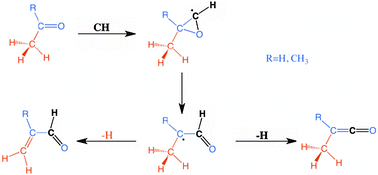Formation of dimethylketene and methacrolein by reaction of the CH radical with acetone†
Abstract
The reaction of the ![[double bond, length as m-dash]](https://www.rsc.org/images/entities/char_e001.gif) O) is studied at room temperature and at a pressure of 4 Torr (533.3 Pa) using a multiplexed photoionization
O) is studied at room temperature and at a pressure of 4 Torr (533.3 Pa) using a multiplexed photoionization

* Corresponding authors
a
Department of Chemistry, West Virginia University, Morgantown, West Virginia 26506, USA
E-mail:
Fabien.goulay@mail.wvu.edu
b School of Chemistry, University of Wollongong, Wollongong, NSW, Australia
c Combustion Research Facility, Mail Stop 9055, Sandia National Laboratories, Livermore, California 94551, USA
The reaction of the ![[double bond, length as m-dash]](https://www.rsc.org/images/entities/char_e001.gif) O) is studied at room temperature and at a pressure of 4 Torr (533.3 Pa) using a multiplexed photoionization
O) is studied at room temperature and at a pressure of 4 Torr (533.3 Pa) using a multiplexed photoionization

 Please wait while we load your content...
Something went wrong. Try again?
Please wait while we load your content...
Something went wrong. Try again?
F. Goulay, A. Derakhshan, E. Maher, A. J. Trevitt, J. D. Savee, A. M. Scheer, D. L. Osborn and C. A. Taatjes, Phys. Chem. Chem. Phys., 2013, 15, 4049 DOI: 10.1039/C3CP43829E
To request permission to reproduce material from this article, please go to the Copyright Clearance Center request page.
If you are an author contributing to an RSC publication, you do not need to request permission provided correct acknowledgement is given.
If you are the author of this article, you do not need to request permission to reproduce figures and diagrams provided correct acknowledgement is given. If you want to reproduce the whole article in a third-party publication (excluding your thesis/dissertation for which permission is not required) please go to the Copyright Clearance Center request page.
Read more about how to correctly acknowledge RSC content.
 Fetching data from CrossRef.
Fetching data from CrossRef.
This may take some time to load.
Loading related content
